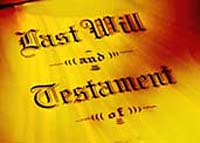
“The father of our country crafted a finely detailed and surprisingly personal will to protect his family and his legacy. Follow in his footsteps, by keeping these three principles in mind: communication, clarity and customization.”
Estate planning for those you love can dramatically change your family for generations. Did you know that in his last will and testament of 1799, George Washington detailed his vision for his legacy? He bequeathed the “use, profit, and benefit” of his whole estate to his “dearly beloved wife Martha Washington.” In addition, he forgave the debts of many of his family members, financed the establishment of a school for orphans, set aside stock for what’s now Washington and Lee University and made arrangements to care for other loved ones.
Kiplinger’s recent article, “Smart Tips for Estate Planning: Write Your Will Like George Washington Did” reports that Washington’s estate plan was more than 5,500 words—the equivalent of nine single-spaced pages.
While your estate planning may not require the same degree of detail, there is an important lesson to be learned from Washington: his writing was personal and captured his exact situation at the time and laid out his future vision. Hopefully, your own estate plan will have the same personalization. However, remember that estate planning isn’t limited to a single legal document.
It is imperative for both spouses to have a good working knowledge of a family’s intentions. Both spouses should participate in drafting the documents to avoid unforeseen complications during stressful times. It is also important for both spouses to be comfortable with the family’s financial adviser, attorney and accountant. In addition, communicating the estate plan to the couple’s children is essential.
Of course, not every spouse will take an eager interest in estate planning, and not every child will want to see the detailed disposition of assets. If this happens to you, put in place a basic protocol, such as “call our estate planning attorney.”
In addition to your last will and testament, you may want to think about a “personal statement of intent” or a “letter of wishes” within your own legacy design. This document works in concert with your will to provide your heirs with a deeper level of personalization and explanation of your rationales. This document is non-binding and typically is accessible only to the people you stipulate, such as your executor, trustee and heirs. A personal statement of intent can help to clarify the rationale behind the provisions of your will.
As you consider your estate plan, think of George and remember the foundational values of communication, clarity and customization.
Reference: Kiplinger (August 9, 2019) “Smart Tips for Estate Planning: Write Your Will Like George Washington Did“











